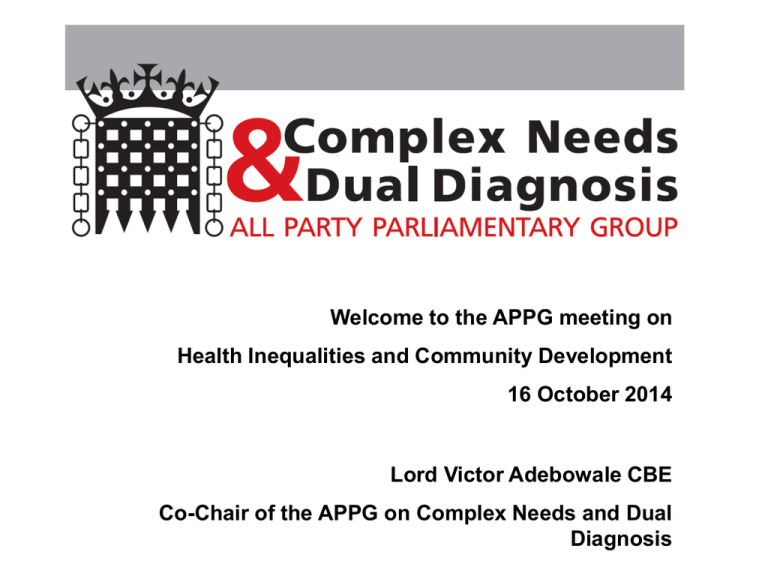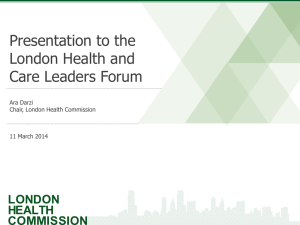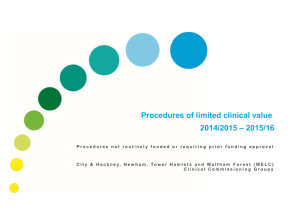
Welcome to the APPG meeting on
Health Inequalities and Community Development
16 October 2014
Lord Victor Adebowale CBE
Co-Chair of the APPG on Complex Needs and Dual
Diagnosis
Speakers:
Brian Fisher, Patient and Public Involvement Lead, NHS
Alliance
Elizabeth Bayliss, Chief Executive of ‘Social Action on Health’ a London based Community development Charity
Dr Niall Macleod, A practising GP in the South West
Community development in
practice
Elizabeth Bayliss
Social Action for Health
• A community development charity with a focus on
health and wellbeing
• Promoting self determination
• Building the confidence of local people, cross
culturally, to become more creative, critical and
reflective in their contributions to social life
• Enlivening public life, since public life makes
fruitful ground for the development of wellbeing
SAfH Spiral of participation
A range of projects – 20 projects
a year
• Advice and information – one to one sessions
• Health improvement – individuals’ health improves
• Community participation – in service improvement,
based on direct experience
• Community leadership – learning new skills to
become more useful
• Mutual support networks – sustaining changes in
lifestyle, new ways of being in the world
• Independent community action – people taking
action for themselves on their own terms
Advice & information
•
•
•
•
Working with 10,000 people a year
across 40 GP surgeries
in Hackney and Tower Hamlets
Raising an extra £ 7 million a year for
spending in local deprived communities
• Supporting 3 networks of community
organisations to collaborate;
• 16 local organisations employ local people as
qualified advisors who work in mother tongue
(so no interpreting costs)
Evidence based direct health
improvement
• Weight management for adults in group
settings
• Diabetes health and wellbeing exercise
groups
• Self management courses (including now,
epilepsy)
Community participation in
service
improvement
• Maternity (Mothers Support Group)
• Mental health (Peoples’ Network)
• Chronic health conditions (Patient
Network)
Mutual support networks
• Peoples Network - mental health userled, user-run self help network
• Patients Network for living with long term
health conditions
• Peer Support Network for people with
severe physical disabilities
Community leadership
• Health Guides: running groups, giving information on services, gathering
narrative on experiences to feed into policy (Tower Hamlets & Wimbledon)
• Mothers support group: recent mothers come together to learn,
mandating, supporting their chosen representatives on the Maternity
Services Liaison Committee (Tower Hamlets & Newham)
• Peer mentors: mentoring others with long term health conditions in self
management
(Westminster, Harrow)
• Community educators: running groups, promoting health and wellbeing
•
•
in community settings, giving information, promoting sharing of experiences,
teaching people how to communicate with professionals (Waltham Forest & Harrow)
Compassionate Neighbours: supporting carers and families of
people dying at home (Hackney)
Patient leaders: representatives of patients, feeding into Healthwatch
(Tower Hamlets)
• Community researchers: community asset auditing, evaluating service
impact.
(Hackney, Tower Hamlets & Harrow)
Independent community
action
Health wisdom groups:
–
Encourage people to use their own health intelligence
–
Get changes made (parks opening hours) through collective action
–
Raise awareness in schools and community settings of health threats (poor eating, transfats,
vitamin D deficiency, drugs and alcohol, risk from no exercise)
–
Teach people how to communicate best with GPs to make best use of services
–
Promote community engagement in research projects (East London Genes and health) that will
benefit society in the longer term.
Complementing the NHS
SAfH brings people together, cross culturally, to
take part in projects that improve their
personal health, offers the opportunity to
share their experiences and join networks for
purposeful action in the public arena.
We have found that many people want to help
their community, and contribute however they
can to the work of the NHS. (for many, many
people, the NHS is the only public institution
they can believe in)
A Charter for Community
Development in Health
Dr Niall MacLeod
GP partner
The Heavitree Practice, Exeter
System flawed
• Created in 1948
• 93% treatment- 7% prevention
• “Should be 50-50” Prof Robert Harris,
Head of NHS strategy
• System over medicalised
• Need a new model
15
Right to Left Shift
Community
Self Care
Healthy
Lifestyle
Prevention
•
•
•
Primary
Care
Secondary
Care
All Stakeholders need to work together in an Integrated Coordinated
strategy for this to work
ie Health and Wellbeing Boards, CCGs, Councils, Voluntary Sector, Faith
Groups, Schools, Industry, Local media, general public etc
We need a Community Development Charter for Health……!
16
Future NHS
• Patient empowerment- involving them in own
health management and prioritising local
health needs
• More emphasis on prevention and developing
health and wellbeing in communities
• Involve pre-existing community, voluntary
and
patient groups
• All these groups working together
• Utilise advances in IT to best effect
17
The Future
• Patient empowerment
• Do things WITH patient not To the patient
• People and communities can help themselves
• Co-produced activity- from the ground up
(Robert Varnam, Head of GP Innovation) NHS England
18
EVIDENCE
• “people with strong social networks live
longer healthier lives compared to those
poorly connected in social terms”
• Prof Alex Haslam- Brisbane University
2012
19
Charter for Community
Development
in Health
• Help focus CCGs, councils, industry on
task at hand
• Benefit NHS by helping reduce demand
• Help develop resilience at grassroots level
20
My VisionIntegrated Coordinated
Healthy Living Strategyfrom GP to Community
• Facilitate shift of healthcare from GP surgery out into healthy
living in healthy communities
•
•
•
•
2.5 years researching locally and nationally
Networked and liaised
All groups keen to be involved
Bring together the key players to share the vision- and get on
with it….!
21
Current Model
• Doctor centred model
• We “sort” everything
advice
prescribe
patient
GP
refer
admit
22
The Health “Ferries”- no coordination…
library
H
E
A
L
T
H
Y
Community
Groups
GP
Friends
Voluntary sector
Public Health
Campaigns
U
N
H
E
A
L
T
H
Y
L
I
F
E
S
T
Y
L
E
23
Working together- a Pontoon
Bridge
Community database
H
E
A
L
T
H
Y
Public Health Campaign
Community
Groups
Friends
library
Apps
Healthy
Living
Advisor
Voluntary sector
Specially Commissioned Services
For High Risk Groups
GP
U
N
H
E
A
L
T
H
Y
L
I
F
E
S
T
Y
L
E
24
Suggested New
Future Community Focused Model
Community database
Community
patient
Communit
y Health
Team
Voluntary
Sector
Healthy living
facilitator
GP
medicatio
n
Hospital
referral
25
GP to Community Shift
• Pharmacies take on minor ailment role
• Practice Health Champions
• Each surgery has healthy living
advisor/facilitator
• Neighbourhood Community Health worker
created in each neighbourhood
• Database of community activities- enroled
in scheme
26
GP to Community Shift
• Specially commissioned activities for at
risk groups eg frail, dementia, obesity,
alcohol, severe mental illness
• GPs buy into change in working patterns
• Develop IT self help – eg approved Apps,
on line self help etc
• Embrace and include all the great
community and voluntary sector resources
27
The Project - “A Integrated Coordinated
Healthy Living Strategy- from GP to Community”
• All groups say it is a good idea FRUSTRATING +++ !
BLOCKS
•
•
•
•
Lack of funding- CCG in financial deficit
Fear of getting it wrong- lack of imaginitive thinking
Lack of body/organisation to coordinate
Population unaware of issues/crisis
• Media and politicians partly to blame for avoiding real
issues
• Lack of direction from Government…..!
• Lack of a Charter…..!
28
Good work
•
•
•
•
•
Bromley By Bow
Green Dreams, Burnley
Altogether Better, Leeds
Age UK, Living Well scheme
Westbank Healthy Living Centre,
Exminster Devon
• Turning Point
• C2 Connecting Communities
29
Benefits to us all
•
•
•
•
•
•
•
•
•
Reduced consultation rate
Reduced prescribing
Reduced A and E attendances
Reduced admissions
Healthier and Happier population
Improved Wellbeing
Reduced crime/drug use
Patients connecting with their communities
Improved resilience- physically and mentally
30
Good Work
•
•
•
•
•
Is happening
Disjointed
Little overall strategy- no coordination
Patchy across UK
Poor sharing of good practice
31
Balance
• Yes we do need high tech treatments
• But with ageing population and increasing demands
• Need to put more emphasis on prevention
• Care in the community
• Need a Charter for Community Development in Health
32
Charter for Community
Development
in Health
•
•
•
•
Good for Primary care
Good for NHS
Good for the individual
Good for the population
33
34
Get A Life
35
A CHARTER FOR
COMMUNITY
DEVELOPMENT IN
HEALTH
DR BRIAN FISHER
NHS ALLIANCE
HEALTH EMPOWERMENT
LEVERAGE PROJECT
SHRINKING
+ AUSTERITY
THE STATE
Threat to
community
life
Increasing
inequality
A crisis in democratic accountability
PARTICIPATORY
ACCOUNTABILITY
DEMOCRATIC
UNDER PRESSURE
• Hollowed out communities
• Threat to mental health
• Attenuation of social
networks
• Weakening of
associational life
• Deterioration in health
• AUSTERITY + REDUCING
THE WELFARE STATE KILLS
PEOPLE.
ASSET-BASED
COMMUNITY DEVELOPMENT
• Statutory services become more
responsive
• Promotes health protection and
community resilience
• Helps tackle health inequalities
• Has an impact on behaviour change
• Saves money
SOCIAL RETURN ON INVESTMENT
• A saving of £559,000 over three years
in a neighbourhood of 5,000 people,
for an investment of £145,000: a return
of 1:3.8
• For £233,655 invested across four
authorities the social return was £3.5
million.
• For every £1 a local authority invests,
£15 of value is created.
“No society has
the money to buy, at market prices,
what it takes to raise children, make a neighbourhood safe,
care for the elderly, make democracy work or address
systemic injustices...
The only way the world is going to address social problems is
by enlisting the very people who are now classified as ‘clients’
and ‘consumers’ and converting them into co-workers, partners
and rebuilders of the core economy.”
EDGAR KAHN
Stronger
C
and
D
deeper
Social
Networks
RESILIENCEENHANCED
CONTROL
Health protection
Resilience to
economic adversity
Better mental health
Can negotiate with
services
More strength for
self-care
Health inequalities
OUTCOMES – HEALTH
6-Month Survival after Heart Attack,
by Level of Emotional Support
70
Sources of
support
Percent died
60
50
0
40
1
30
2 or more
20
10
0
Men
Women
SOCIAL NETWORKS
REDUCE MORTALITY RISK
• 50 % increased likelihood of survival for people
with stronger social relationships .
• Comparable with risks such as smoking, alcohol,
BMI and physical activity.
• Consistent across age,
sex, cause of death.
• 2010 meta-analysis of data [1] across 308,849 individuals,
followed for an average of 7.5 years
1] Social relationships and mortality risk: a meta-analytic review. Holt-Lunstadt, Smith,
Bradley Layton.Plos Medicine July 2010, Vol 7, Issue 7. www.plosmedicine.org
doi:10.1371/journal.pmed.1000316
PRINCIPLES FOR SOCIAL ACTION
ON HEALTH
• Enable people to organise and collaborate to:
• identify their own needs
• take action to exert influence on the decisions which affect their
lives
• improve the quality of their own lives, the communities in which
they live, and societies of which they are a part.
• Address imbalances in power and bring about change
founded on social justice, equality and inclusion.
• Active communities make a marked difference to their
own health
and life expectancy.
• Co-production between communities and service providers
thrives if communities are enabled to become leading players in their
own interests.
• Look for the strong, not the wrong:
a needs-and-assets based approach
WE CALL ON HEALTH
AND OTHER AGENCIES TO:
• Inspire residents to become key players in
developing their own health and well-being.
• Be prepared to listen, respond and work in new
ways.
• Harness the interventions that have the best
evidence and are most reproducible. These include
community development or community building or
community transformation
• Develop, through community building, community
led neighbourhood partnerships of residents
and service providers.
POLICIES FOR SOCIAL ACTION ON
HEALTH
• A community development strategy in every Health
and Well-Being Board and CCG.
• Joint Strategic Needs Assessments to become Joint
Strategic Needs and Assets Assessments
• Support investment in community development and
social value.
• Devolve decision making about service commissioning
to communities undistorted by competition rules and
commercial confidentiality.
• All CCGs to collect evidence of local
community development.
POLICIES FOR SOCIAL ACTION ON
HEALTH 2
• Workforce capacity and capability in community
development ensured by Health Education England
and LETBs.
• A community development work programme
developed by Public Health England.
• Commissioning and delivering evidence based
community development should be supported by
Public Health England and NHSE Regional Teams in
local authorities and other public health bodies.
www.healthempowerment.co.uk
Questions and discussion
Our next meeting is at 1pm on the 19 Jan 2015
You can find more information on the APPG or
contact us via:
WEBSITE: www.turning-point.co.uk/whoarewe/appg
TWITTER: http://twitter.com/APPGcomplexneed
EMAIL: appg@turning-point.co.uk









